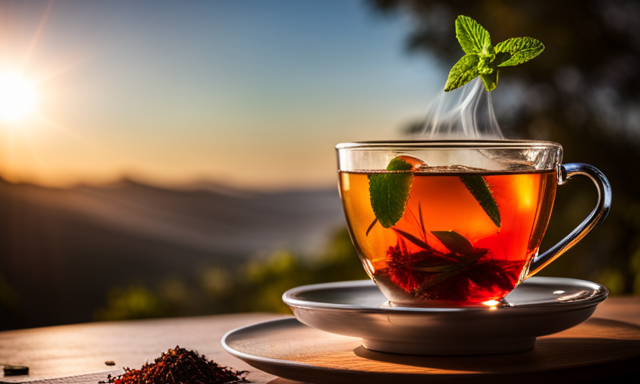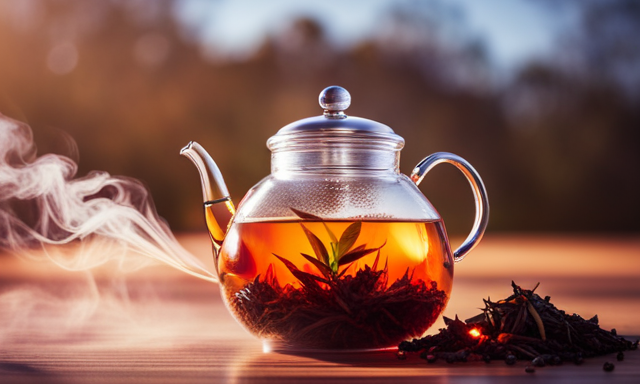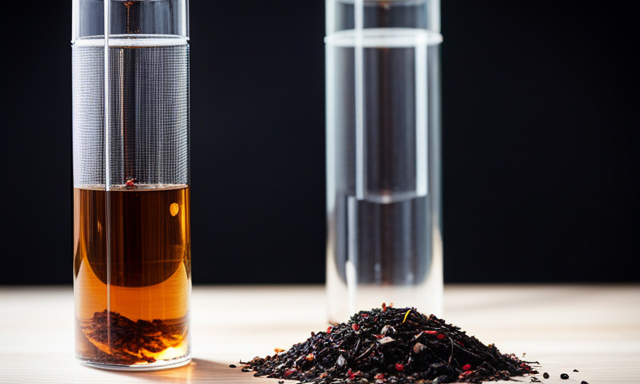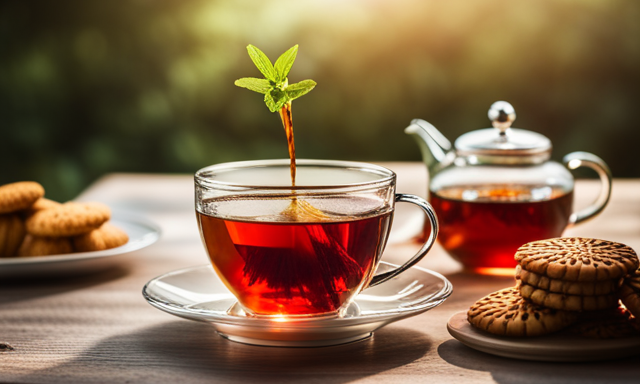Picture yourself in a cozy café, seeking solace from the bustling world outside. As you peruse the menu, your eyes catch the intriguing name: rooibos tea. Your curiosity piqued, you wonder what kind of tea this could be.
Allow me to be your guide in unraveling the mysteries of rooibos tea.
Rooibos tea, derived from the leaves of the Aspalathus linearis plant, hails from the majestic lands of South Africa. Its distinct flavor profile, with notes of nuttiness and a hint of sweetness, sets it apart from other teas. But rooibos tea offers more than just a delightful taste. It boasts a plethora of health benefits, from its rich antioxidants to its ability to promote relaxation and aid digestion.
Join me on a journey as we explore the different types of rooibos tea, its culinary applications, and the sustainable farming practices that make it truly special. Let’s delve into the vibrant rooibos tea culture of South Africa and embrace the delightful world of this unique beverage.
Key Takeaways
- Rooibos tea is derived from the leaves of the Aspalathus linearis plant in South Africa.
- It has a distinct flavor profile with nutty and sweet notes, and is naturally sweet with a vibrant red color.
- Rooibos tea is rich in antioxidants and offers various health benefits, including boosting the immune system, aiding digestion, and having anti-inflammatory properties.
- There are different types of rooibos tea, including traditional, fermented, and green, each with its own unique characteristics and taste.
Origins of Rooibos Tea
The origins of rooibos tea can be traced back to the indigenous people of South Africa. This unique tea is made from the leaves of the aspalathus linearis plant, which is native to the Cederberg region of the country.
The plant has been used for centuries by the Khoisan people for its medicinal properties and is known for its vibrant red color and naturally sweet taste. Rooibos tea is not only delicious, but it also offers numerous health benefits. It is rich in antioxidants, which can help boost the immune system and protect against diseases.
Additionally, it is caffeine-free and low in tannins, making it a great choice for those who are sensitive to caffeine or have digestive issues. With its rich history and impressive health benefits, rooibos tea is truly a remarkable beverage.
Now, let’s delve into the fascinating world of the aspalathus linearis plant.
The Aspalathus Linearis Plant
Explore the fascinating origins of this unique South African beverage as you delve into the secrets of the Aspalathus Linearis plant.
The Aspalathus linearis plant, also known as the Rooibos plant, is a shrub that is native to the Cederberg region of South Africa. Cultivation of this plant is a delicate process that requires specific conditions to thrive. The plant is grown in sandy soil and requires a Mediterranean climate with hot summers and cold winters.
Once the plant is mature, it is carefully harvested and processed to create the beloved Rooibos tea. The leaves and stems of the plant are cut, bruised, and fermented before they are dried in the sun. This unique production method is what gives Rooibos tea its distinct flavor and aroma.
Transitioning into the subsequent section about the flavor profile of Rooibos tea, one cannot ignore the remarkable journey it takes from plant to cup.
Flavor Profile of Rooibos Tea
Immerse yourself in the rich tapestry of flavors found in a warm cup of Rooibos tea, as you savor the earthy undertones and hints of natural sweetness that dance on your palate. This remarkable herbal infusion boasts a unique flavor profile that sets it apart from other teas.
The deep, woody notes of Rooibos tea are reminiscent of a walk through a sun-drenched forest, creating a warm and comforting sensation with every sip. Its subtle nuttiness adds a delicate complexity, enhancing the overall taste experience. The smooth, velvety texture of Rooibos tea completes the sensory delight, caressing your taste buds with every mouthful.
Indulging in a cup of Rooibos tea not only promises a delightful taste experience but also offers a plethora of health benefits.
Transitioning seamlessly into the next section, let’s explore the remarkable health benefits of this extraordinary tea.
Health Benefits of Rooibos Tea
Indulging in a cup of this extraordinary herbal infusion promises a plethora of health benefits. Rooibos tea isn’t just a delicious beverage, but it also boasts a range of advantages for your well-being. Packed with antioxidants, it can help boost your immune system and protect against free radicals.
Additionally, rooibos tea has anti-inflammatory properties, which can aid in reducing inflammation and promoting overall health. This remarkable tea is also caffeine-free, making it a great choice for those looking to decrease their caffeine intake.
When it comes to brewing techniques, steeping rooibos tea for 5-7 minutes at 212°F will yield the best results.
As we delve into the different types of rooibos tea, you’ll discover the unique characteristics and flavors that each one offers.
Types of Rooibos Tea
When it comes to types of Rooibos tea, there are a few key points to consider. First, there’s traditional and fermented Rooibos, which undergoes a fermentation process that gives it a unique flavor profile.
Then, there’s green Rooibos, which is unfermented and has a lighter, more delicate taste.
Finally, there are Rooibos blends, which can be flavored or infused with other herbs to create a wide range of delicious and aromatic options.
Exploring these different types of Rooibos tea is a journey into the diverse world of this South African herbal tea.
Traditional and Fermented Rooibos
Try brewing yourself a cup of traditional or fermented rooibos tea to experience its unique flavor and soothing qualities. Traditional rooibos tea is made by allowing the leaves of the rooibos plant to oxidize naturally, resulting in a rich, reddish-brown color and a slightly sweet taste. This type of rooibos tea is known for its numerous health benefits, including its high levels of antioxidants and its ability to promote relaxation and improve sleep quality.
Fermented rooibos, on the other hand, undergoes a longer oxidation process, resulting in a darker color and a more robust, earthy flavor. This type of rooibos tea is often favored by those who enjoy stronger, bolder flavors.
As we move on to explore green rooibos and rooibos blends, you’ll discover even more delightful variations of this versatile tea.
Green Rooibos and Rooibos Blends
Savor the vibrant and refreshing dance of flavors in a cup of invigorating green rooibos or a tantalizing blend that will transport your taste buds to a tropical paradise. Green rooibos, derived from the same plant as traditional rooibos, is unfermented, resulting in a lighter and more delicate flavor profile. This exquisite tea is known for its numerous health benefits, including being rich in antioxidants and promoting a healthy immune system.
In addition to green rooibos, rooibos blends have gained popularity among tea enthusiasts. These blends combine the natural sweetness and nuttiness of rooibos with a variety of flavors, creating a truly unique and enjoyable tea experience. From fruity blends like mango passionfruit to indulgent blends like chocolate mint, there is a rooibos blend to suit every palate.
Transitioning into the subsequent section about flavored and herbal infusions, the world of tea offers an endless array of options to explore.
Flavored and Herbal Infusions
Moving on from Green Rooibos and Rooibos Blends, let’s explore the world of flavored and herbal infusions. This category offers an exciting array of options for those seeking a unique twist to their tea experience.
Flavored rooibos teas combine the earthy and woody notes of rooibos with various natural flavors, such as fruits, spices, and flowers. These delightful combinations create a harmonious blend of taste and aroma that can satisfy any palate.
Herbal infusions, on the other hand, consist of a diverse range of plants and herbs, each with its own distinctive flavor profile and health benefits. From soothing chamomile to invigorating peppermint, these teas offer a refreshing and rejuvenating experience. Not only do they provide a delightful taste, but they also provide various health benefits, such as promoting relaxation, aiding digestion, and boosting the immune system.
Now, let’s delve into the art of brewing and serving rooibos tea, where we will discover the secrets to unlocking its full potential.
Brewing and Serving Rooibos Tea
When brewing and serving Rooibos tea, it’s essential to pay attention to water temperature and steeping time. Rooibos tea is best brewed with water that’s heated to a temperature of 200°F (93°C) and steeped for about 5-7 minutes to extract its full flavor.
Adding milk, sugar, or honey is a matter of personal preference and can enhance the taste of Rooibos tea.
Additionally, for those who prefer a refreshing and cool option, there are various iced Rooibos tea variations available, offering a delightful twist to this beloved herbal beverage.
Water Temperature and Steeping Time
To get the perfect cup of rooibos tea, it’s important to know the ideal water temperature and steeping time. Here are three key factors to consider when brewing rooibos tea:
-
Water temperature: Rooibos tea should be steeped in water that’s brought to a boil and then allowed to cool slightly. The optimal water temperature for rooibos tea is around 200°F (93°C). This temperature allows the tea leaves to release their flavors without becoming bitter.
-
Steeping time: Rooibos tea should be steeped for about 5 to 7 minutes. This allows enough time for the tea leaves to infuse the water and create a rich, flavorful brew. Steeping for longer can result in a stronger taste, but be careful not to oversteep as it can lead to a bitter taste.
-
Remember to adjust the water temperature and steeping time based on personal preference. Experiment with different durations to find the balance that suits your taste.
Now that we’ve covered the water temperature and steeping time, let’s move on to the next step of adding milk, sugar, or honey to enhance the flavor of your rooibos tea.
Adding Milk, Sugar, or Honey
One way to elevate the taste of your brew is by adding a touch of creamy milk, a hint of sweetness from sugar, or the natural sweetness of honey.
Rooibos tea is versatile and can be enjoyed plain or with the addition of these complementary ingredients. Personally, I find that adding a squeeze of fresh lemon to my rooibos tea brings a refreshing citrus twist that balances the earthy flavors. Additionally, exploring different rooibos flavors such as vanilla, caramel, or fruity variations can enhance the overall experience.
These subtle additions can transform a simple cup of rooibos tea into a delightful treat for the senses.
Now, let’s move on to the next section and discover the delightful variations of iced rooibos tea.
Iced Rooibos Tea Variations
When it comes to enjoying Rooibos tea, there are various ways to enhance its flavor profile. In my previous subtopic, we discussed adding milk, sugar, or honey to create a delightful cup of hot Rooibos tea. Now, let’s delve into the world of iced Rooibos tea variations.
Iced Rooibos tea is not only refreshing but also offers numerous health benefits. It can be prepared in a variety of ways, such as fruit-infused, herbal blends, or even combined with other teas like green tea or mint. To engage your taste buds and keep you cool on a warm day, consider trying recipes like a zesty lemon and ginger iced Rooibos tea or a fruity berry and hibiscus iced Rooibos tea.
Drinking iced Rooibos tea provides a multitude of benefits, including its antioxidant properties, aiding digestion, and promoting hydration. Now that we’ve explored the refreshing world of iced Rooibos tea, let’s move on to discovering how Rooibos tea can be utilized in culinary applications.
Rooibos Tea in Culinary Applications
Rooibos tea is commonly used in culinary applications, adding a unique flavor to dishes and beverages. Its distinct taste, which is often described as earthy, nutty, and slightly sweet, lends itself well to a variety of recipes. Culinary creativity knows no bounds when it comes to incorporating rooibos tea into both savory and sweet dishes. From marinades and sauces to desserts and cocktails, the possibilities are endless.
To give you an idea of the versatility of rooibos tea in culinary applications, let me present you with a table that showcases three mouthwatering recipes that feature this exceptional ingredient. Get ready to tantalize your taste buds with dishes like Rooibos Glazed Salmon, Rooibos-infused Chocolate Truffles, and Rooibos Mojito. Each recipe combines the unique flavors of rooibos tea with other ingredients to create a truly unforgettable dining experience.
As we explore the culinary applications of rooibos tea, it’s important to note its connection to sustainable farming practices.
Rooibos Tea and Sustainable Farming
When it comes to sustainable farming practices in the production of Rooibos tea, organic and fair trade practices take center stage. As a knowledgeable consumer, I understand the importance of choosing organic Rooibos tea as it’s grown without harmful chemicals or pesticides.
Additionally, supporting fair trade practices ensures that the farmers receive a fair wage for their hard work, promoting social and economic sustainability.
From an environmental standpoint, Rooibos tea cultivation brings numerous benefits, such as promoting soil health and biodiversity.
Lastly, conservation efforts play a significant role in preserving the delicate ecosystems where Rooibos tea is grown, ensuring its availability for future generations to enjoy.
Organic and Fair Trade Practices
By choosing organic and fair trade rooibos, you can make a positive impact on both your health and the well-being of tea farmers. Here are four reasons why opting for organic farming and fair trade certification is a wise choice when it comes to your tea selection:
-
Health Benefits: Organic rooibos is grown without the use of synthetic pesticides or fertilizers, ensuring that you’re consuming a product free from harmful chemicals.
-
Environmental Preservation: Organic farming practices promote biodiversity, protect soil health, and conserve water resources, helping to preserve the natural environment.
-
Fair Wages and Working Conditions: Fair trade certification ensures that tea farmers receive fair compensation for their work and are provided with safe and humane working conditions.
-
Community Support: By purchasing fair trade rooibos, you’re supporting communities and empowering small-scale farmers to improve their livelihoods.
Choosing organic and fair trade rooibos not only benefits your health but also contributes to a more sustainable and equitable tea industry.
In the next section, we’ll explore the environmental benefits and conservation efforts associated with rooibos tea.
Environmental Benefits and Conservation Efforts
Choosing organic and fair trade practices for tea production not only supports the health and well-being of farmers but also contributes to significant environmental benefits. For example, it reduces carbon emissions by 30% compared to conventional farming methods. These environmental impacts are particularly noteworthy in the production of rooibos tea, which is grown in the unique fynbos biome of South Africa, known for its rich biodiversity.
By adopting organic and fair trade practices, farmers help preserve this delicate ecosystem. They ensure the conservation of native plant species and the protection of wildlife habitats. Moreover, these sustainable farming methods promote soil health, reduce water usage, and minimize the use of synthetic pesticides and fertilizers.
Through responsible tea production, we can enjoy the exquisite flavors and cultural heritage of rooibos tea while safeguarding the natural environment for future generations.
Now, let’s dive into exploring the captivating rooibos tea culture in South Africa.
Exploring Rooibos Tea Culture in South Africa
Rooibos tea, deeply rooted in South African culture, offers a unique tea-drinking experience. It holds a significant place in traditional rituals and is an integral part of South African heritage. The rich history of Rooibos tea can be traced back centuries, where it was used for its medicinal properties and enjoyed during social gatherings. Today, Rooibos tea continues to be cherished and celebrated in South Africa.
In popular culture, Rooibos tea has gained international recognition for its distinct flavor and health benefits. It has become a favorite among tea enthusiasts worldwide, with its earthy and sweet taste captivating the senses.
- Rooibos tea is enjoyed hot or cold, making it a versatile beverage for any season.
- Its caffeine-free nature makes it a perfect choice for those seeking a soothing and relaxing drink.
- The antioxidants present in Rooibos tea contribute to overall well-being and promote a healthy lifestyle.
As we delve into the delightful world of Rooibos tea, we will discover its diverse flavors, health benefits, and the joy it brings to tea lovers everywhere.
Transitioning into the subsequent section, we will explore the conclusion: embracing the delightful world of Rooibos tea.
Conclusion: Embracing the Delightful World of Rooibos Tea
After delving into the rich tapestry of Rooibos tea culture in South Africa, it’s impossible not to be captivated by its allure. Now, as we conclude our exploration, let’s embark on a journey of embracing the delightful world of Rooibos tea.
There are countless ways to enjoy this exquisite brew, each offering a unique sensory experience. Whether sipping it plain to relish its natural flavors or infusing it with a hint of honey for a touch of sweetness, the versatility of Rooibos tea knows no bounds.
What’s truly remarkable is the global popularity of Rooibos tea. From its humble beginnings in South Africa, it has traversed continents and found its place in the hearts of tea enthusiasts worldwide. Its soothing properties and distinct taste have made it a beloved beverage in countries like Japan, Germany, and the United States, where it’s become a staple in many households.
In conclusion, Rooibos tea is a treasure that deserves to be cherished and celebrated. So, let’s raise our cups and toast to the joyous journey of embracing the delightful world of Rooibos tea.
Frequently Asked Questions
How long does it take for the Aspalathus Linearis plant to grow and be ready for harvesting?
It takes the aspalathus linearis plant a few years to grow and be ready for harvesting. The growth time is a gradual process that requires patience and proper care. The harvesting process involves carefully selecting the leaves and stems at their peak of maturity.
Can rooibos tea help with weight loss?
Rooibos tea has weight loss benefits, supported by scientific research. It aids in reducing appetite, increasing metabolism, and promoting fat oxidation. Incorporating rooibos tea into a balanced diet and exercise routine can support weight loss goals.
Are there any potential side effects or risks associated with drinking rooibos tea?
While there are numerous potential health benefits associated with drinking rooibos tea, it is important to be aware of potential side effects and risks. It is recommended to consume rooibos tea in moderation and within the recommended daily intake.
What is the caffeine content of rooibos tea?
Rooibos tea is a caffeine-free herbal infusion. It offers various health benefits, such as promoting heart health, aiding digestion, and boosting the immune system. Its caffeine content is zero, making it a great choice for those looking for a caffeine-free alternative.
Can rooibos tea be used as a natural remedy for skin conditions like eczema or acne?
As a tea aficionado, I must say that using Rooibos tea as a natural remedy for skin conditions like eczema or acne is a game-changer. Its potential benefits for overall skin health and complexion are truly remarkable.
Conclusion
As I conclude this journey into the delightful world of Rooibos tea, I can’t help but be captivated by its origins, flavors, and health benefits.
While some may argue that its taste lacks the complexity of other teas, I believe that its unique earthy and sweet notes offer a refreshing and comforting experience.
Moreover, its sustainable farming practices make it a conscious choice for tea enthusiasts.
So, let’s embrace the wonders of Rooibos tea and savor every sip of this remarkable beverage.










